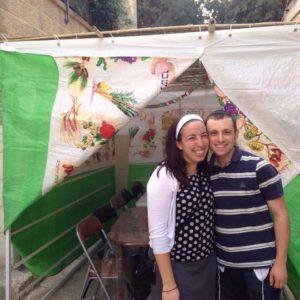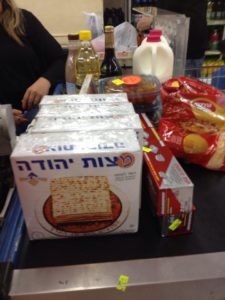Major Jewish Holidays
Some of our most important Jewish holidays are observed in a similar way to Shabbat, but each commemorates a different story, occasion, miracle, or something of the like. Each holiday has a central theme, usually accompanied by huge awesome meals (except for Yom Kippur, which is a fast day).
The major holidays in Judaism have the status of “Yom Tov,” literally meaning “good day.” The laws of Shabbat apply to the observance of Yom Tovs (with a few, unexciting exceptions for your purposes… unless you really care about carrying objects outside of a private area). Just like Shabbat, people don’t use electricity so no phones or cars, dress in their finest clothing, enjoy huge festive meals, and go to synagogue for special services designed for the holiday. Here’s a brief synopsis of each of our major holidays. (The four holidays that come all at once in the Fall- Rosh Hashana, Yom Kippur, Sukkot, and Simhat Torah- are known as the “High Holidays”).

Rosh Hashana
When: Around September for two days
What: The new year! We dip apples in honey. If you’ve never tried it, you should.
Why: Our New Years is not a huge party the way January 1st is. It’s more a serious but beautiful time of reflection. Yom Kippur (the Day of Atonement) is right around the corner, so people are reflecting on what they did well the year before, what they did wrong, who they should apologize to in the coming days, how they want to improve in the coming year, and what they hope G-d will give them in this new year. It’s a time of intense prayer but also celebration for reaching this point in our lives.
Yom Kippur
When: 10 days after Rosh Hashana (the days in between are known as the Ten Days of Awe), for one day
What: You fast- no eating or drinking. No wearing leather. Many people wear all white.
Why: This is the holiest day of the year (tied with Shabbat). It’s the Day of Atonement, where G-d is sealing your fate in the Book of Life or Death. There’s a belief that G-d literally writes down what will happen to you in the next year, what good and bad will befall you, and you pray your heart out that he judges you and your community favorably. It’s a very humbling day. You stand before G-d, with the Gates of Heaven directly open to you, begging for forgiveness, but also holy like angels. The day ends with the harrowing sound of a ram’s horn being blown like a trumpet. It’s sobering and beautiful.
Sukkot

When: Around October, following Yom Kippur, for 7 or 8 days (depending on if you’re inside or outside of Israel)
What: We build little huts in our backyards called a “sukkah,” eat all of our meals in the hut, and even sleep in the hut. We also shake around a very specific combination of branches and a fruit called an etrog (really similar to a lemon). Yeah, no good way to explain that… It has to do with beautiful metaphors about the different pieces of humanity. But yes, we shake a branch around.
Why: If you’re doing some casual reading in the Old Testament (i.e. what we call the Torah) and stumble upon the Festival of Tabernacles, that’s this one. It’s mentioned several times in the 5 Books. When G-d brought us out of Egypt, we wandered in the desert and lived in huts. Hence the huts. Remaking the whole hut thing reminds us that G-d provides for all of our needs. In terms of the feel of the day, it’s known as “Zman Simchateinu,” or the time of our happiness. This holiday shifts from the serious moods of Rosh Hashana and Yom Kippur into total celebration. It reminds us that the real definition of happiness is not about living in a mansion with lots of material possessions; rather we sit in a simple hut under the stars, remembering that happiness comes from appreciating all that G-d already gives us.
Simhat Torah
When: Day after Sukkot (also October time)
What: We finish reading the Torah and start it from the beginning again, which is cause for major celebration. Lots of dancing with the Torah and singing and celebrating!
Why: Every year, Jewish communities all over the world chant the entire Torah out loud in portions read each week in synagogue. Simhat Torah is when we finish reading the entire Torah and then start reading it from the beginning again (we would never want there to be a single moment that we weren’t learning Torah.) Reading through all 5 books is a big accomplishment and cause for celebration! There’s tons of dancing and pure elation. This is one of my favorite holidays.
Passover (Pesach)
When: Spring time (usually some time in April) for 7 or 8 days depending on if you’re inside or outside of Israel

What: We have a “Passover seder” which is a dinner that starts and ends with a long ceremony-type thing in which we read out of a book called the Haggadah, detailing the Passover story. Have you ever heard of matzah? It’s like a huge square cracker. We eat lots of that because, for the entirety of the holiday, we can’t eat anything that has “chametz” in it, which are leavened foods. It’s not just not eating bread- it’s literally switching over our entire kitchens, using special dishes we save for Passover, sweeping out every single crumb from our houses and cars… Preparation for this holiday is like Spring Cleaning on steroids.
Why: You’ve heard of the whole story of Jews being slaves in Egypt and then Moses teaming up with G-d to free them from Pharoah, culminating in the whole splitting of the Red Sea thing? Yep, that’s Passover. If splitting a sea and being liberated from slavery aren’t cause for celebration, I’m not sure what is. I wish we didn’t celebrate by not eating anything with leavened food it in- it affects way more foods that you’d think. Because I’m from an Eastern European tradition line (Ashkenazi), I can’t even eat legumes, so no corn or rice for me. The whole reason for the no-leavened-foods thing is because we were in a hurry when we left Egypt, so we didn’t have time for our bread to rise. Overall, it’s a very nit-picky holiday in terms of practice, but it’s also a huge time of celebration and thanking G-d for our freedom.
Shavuot
When: Seven weeks after Passover, usually in June (one or two days depending on if you’re in or outside of Israel)
What: We stay up the whole night studying Torah. And eat cheesecake.
Why: This is the holiday celebrating when G-d gave us the Torah on Mt. Sinai. We count every single day from Passover through Shavuot, anticipating the receiving of the Torah. Shavuot is then the culmination of this anticipation, literally staying up all night learning Torah in celebration. What better way to celebrate receiving the Torah then to really dive in and study the text?